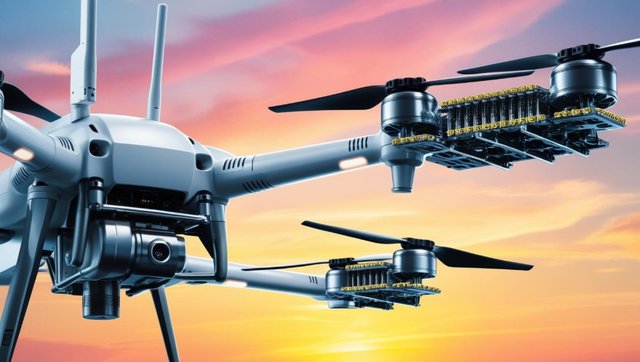The Rising Demand for Hybrid Models in the Drone Communication Market

The Drone Communication Market is poised for remarkable growth, with its valuation projected to escalate from USD 2.58 billion in 2024 to USD 14.49 billion by 2030, reflecting a robust CAGR of 21.2%. This exponential rise is driven by technological advancements and an increasing reliance on unmanned aerial vehicles (UAVs) for military, commercial, and industrial applications. As drones continue to play pivotal roles in surveillance, delivery systems, and reconnaissance, advancements in communication systems have become the backbone of their operational efficiency.
From enabling real-time data transmission to ensuring secure command and control, drone communication systems have evolved to meet the dynamic needs of modern applications. Let's delve deeper into the forces driving this market and the challenges it faces.
Download PDF Brochure: https://www.marketsandmarkets.com/pdfdownloadNew.asp?id=220457835
Key Market Drivers: Transformative Technologies Fueling Growth
One of the most significant drivers of the drone communication market is the integration of 5G and IoT technologies. These innovations are revolutionizing drone connectivity, unlocking new possibilities for high-definition video streaming, autonomous navigation, and real-time data analytics. With ultra-low latency and faster data transfer speeds, 5G networks have become indispensable for applications like Beyond Visual Line of Sight (BVLOS) operations and urban air mobility.
IoT, on the other hand, extends the communication ecosystem by creating interconnected networks of drones and sensors, enabling seamless data exchange. This synergy enhances operational efficiency, reliability, and scalability, positioning 5G and IoT as transformative forces in the drone communication industry.
The adoption of hybrid communication models further strengthens the market's potential. By integrating SATCOM, 5G, and RF technologies, these models provide flexibility and resilience, ensuring uninterrupted connectivity even in challenging environments. This adaptability is particularly valuable in applications like disaster response and military operations, where reliable communication is critical.
Challenges in the Drone Communication Landscape
Despite its promising trajectory, the drone communication market is not without challenges. High costs associated with advanced communication systems act as a barrier to widespread adoption. Sophisticated components like SATCOM modules and encrypted transceivers are essential for secure, long-range operations but carry significant expenses. For small- and medium-sized enterprises in sectors like agriculture and logistics, these costs can be prohibitive, limiting the scalability of drone technology.
Another pressing challenge is data security. As drones increasingly rely on real-time communication, they become vulnerable to cyber threats such as hacking, jamming, and data breaches. The absence of standardized security protocols exacerbates these risks, necessitating significant investments in encryption technologies and cybersecurity solutions. Addressing these vulnerabilities requires collaborative efforts from industry stakeholders, regulatory bodies, and technology providers.
Ask for Sample Report: https://www.marketsandmarkets.com/requestsampleNew.asp?id=220457835
Opportunities: The Rise of Hybrid Communication Models
The adoption of hybrid communication systems presents a lucrative opportunity for the drone communication market. By combining multiple technologies, hybrid models offer unparalleled flexibility and resilience. For instance, a drone operating in a BVLOS scenario can switch seamlessly between SATCOM for long-range communication and 5G for urban operations.
This capability is particularly beneficial in military applications and disaster response scenarios, where robust and adaptive connectivity is crucial. As industries recognize the value of hybrid models, the demand for such systems is expected to surge, driving innovation and investment in the market.
Regional Insights: North America Leads the Way
North America is poised to dominate the drone communication market during the forecast period, driven by the widespread adoption of drones across various sectors. The region's well-established 5G infrastructure and robust R&D investments provide a fertile ground for market growth.
The presence of leading drone manufacturers and technology providers further reinforces North America's position as a market leader. As industries in the region continue to explore innovative applications of drone technology, the demand for advanced communication systems is set to rise.
Future Outlook: A Transformative Journey Ahead
The drone communication market's future is marked by innovation and growth. As technologies like AI-based communication protocols and modular systems gain traction, drones are becoming more autonomous and efficient. The integration of advanced cybersecurity measures will address data security concerns, paving the way for widespread adoption.
With a projected market value of USD 14.49 billion by 2030, the drone communication industry is on the cusp of a transformative journey. Stakeholders across the value chain must collaborate to overcome challenges and seize opportunities, ensuring that drones continue to revolutionize industries worldwide.
To Gain Deeper Insights Into This Dynamic Market, Speak to Our Analyst Here: https://www.marketsandmarkets.com/speaktoanalystNew.asp?id=220457835
FAQs: Understanding the Drone Communication Market
Q: What is driving the growth of the Drone Communication Market?
A: The market's growth is driven by advancements in 5G and IoT technologies, the adoption of hybrid communication models, and the increasing demand for drones across various applications.
Q: What are the major challenges in the market?
A: High costs of advanced communication systems and data security concerns are significant challenges limiting market adoption.
Q: Which region is expected to lead the market?
A: North America is projected to dominate the market, owing to its robust infrastructure and significant investments in drone technology.
Q: What are hybrid communication models, and why are they important?
A: Hybrid communication models combine multiple technologies like SATCOM, 5G, and RF to ensure uninterrupted connectivity. They are essential for applications requiring reliable and adaptive communication.
Q: How does 5G enhance drone communication?
A: 5G offers ultra-low latency, faster data transfer speeds, and greater reliability, enabling real-time data transmission, autonomous navigation, and high-definition video streaming.
The Drone Communication Market is a dynamic and rapidly evolving landscape, offering immense potential for innovation and growth. With advancements in technology and strategic investments, this industry is set to reshape the future of connectivity and automation.